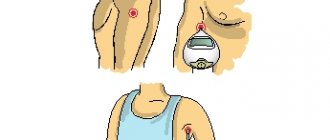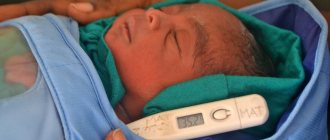Types of body temperature
Depending on the thermometer readings, the following types of body temperature are distinguished:
— Reduced and low body temperature: less than 35°C; — Normal body temperature: 35°C – 37°C; - Low-grade body temperature: 37°C - 38°C; — Febrile body temperature: 38°C - 39°C; - Pyretic body temperature: 39°C - 41°C; - Hyperpyretic body temperature: above 41°C.
According to another classification, the following types of body temperature (body condition) are distinguished:
- Hypothermia. Body temperature drops below 35°C;
- Normal temperature. Body temperature ranges from 35°C to 37°C (depending on the state of the body, age, gender, moment of measurement and other factors);
- Hyperthermia. Body temperature rises above 37°C;
- Fever. An increase in body temperature, which, unlike hypothermia, occurs while maintaining the body’s thermoregulation mechanisms.
Reduced and low body temperature
Low body temperature is less common than high or high body temperature, but nevertheless, it is also quite dangerous for human life. If the body temperature drops to 27°C or lower, there is a chance that a person will fall into a coma, although there are cases when people survived hypothermia down to 16°C.
The temperature of an adult healthy person is considered low if it is below 36.0°C. In other cases, a low temperature should be considered a temperature that is 0.5°C - 1.5°C below your normal temperature.
Body temperature is considered low if it is more than 1.5°C lower than your normal body temperature, or if your temperature drops below 35°C (hypothermia). In this case, you must urgently call a doctor.
Reasons for low temperature:
- weak immunity; - severe hypothermia; - a consequence of an illness; - thyroid disease; - medications; - decreased hemoglobin; - hormonal imbalance - internal bleeding; - poisoning - fatigue, etc.
The main and most common symptoms of low temperature are loss of strength and dizziness.
Prevention
To prevent hypothermia, a person needs to follow simple rules of a healthy lifestyle:
- get rid of bad habits;
- normalize work schedule and rest time;
- engage in moderate physical activity;
- regularly ventilate the apartment or house;
- take a contrast shower;
- to walk outside;
- follow the rules of rational nutrition;
- take vitamins.
Reducing stressful situations also affects a person’s general condition and can help normalize the body’s temperature.
Normal body temperature
Normal body temperature, as many experts note, mainly depends on age and time of day.
Let's consider the values of the upper limit of normal body temperature in people of different ages, if measured under the arm:
— normal temperature in newborns: 36.8°C; - normal temperature in 6 month old babies: 37.4°C; - normal temperature in 1 year old children: 37.4°C; - normal temperature in 3 year old children: 37.4°C; - normal temperature in 6 year old children: 37.0°C; — normal temperature in adults: 36.8°C; — normal temperature in adults over 65 years of age: 36.3°C;
If you measure the temperature not under the arms, then the readings of the thermometer (thermometer) will differ:
- in the mouth - 0.3-0.6°C more; - in the ear cavity - more by 0.6-1.2°C; - in the rectum - more by 0.6-1.2°C.
It is worth noting that the above data are based on a study of 90% of patients, but at the same time, 10% have a body temperature that differs up or down, and at the same time, they are absolutely healthy. In such cases, this is also the norm for them.
In general, temperature fluctuations up or down from the norm by more than 0.5-1.5 ° C are a reaction to any disturbances in the functioning of the body. In other words, this is a sign that the body recognized the disease and began to fight it.
If you want to know the exact indicator of your normal temperature, consult your doctor. If this is not possible, then do it yourself. To do this, you need to take temperature measurements over several days, when you feel great, in the morning, afternoon and evening. Write down the thermometer readings in your notebook. Then separately add up all the indicators of morning, afternoon and evening measurements and divide the sum by the number of measurements. The average value will be your normal temperature.
Treatment of the disease
In case of pneumonia, comprehensive treatment of pneumonia in adults is mandatory. It consists of:
- mode correction;
- drug treatment;
- physiotherapeutic treatment;
- application of traditional medicine treatment recipes approved by a doctor.
When the symptoms of pneumonia are confirmed, the doctor gives an objective assessment of the severity of the condition and decides how to treat - outpatient or inpatient.
Typically, patients with pneumonia are hospitalized in the general medical department of a hospital or the pulmonology department. In case of severe intoxication and fever, in addition to the main treatment, you need to drink a lot, stay in bed, and eat high-calorie foods enriched with vitamins. In case of obvious respiratory failure, oxygen inhalation is indicated.
The main stage of therapy is antibacterial treatment. Broad-spectrum antibiotics are prescribed immediately, without waiting for the pathogen to be identified through diagnosis. Only a doctor can choose an antibiotic; self-treatment with these drugs for adults and children is unacceptable. For an unknown pathogen, as a rule, treatment includes 2 or 3 drugs at once. The course lasts from 7 to 14 days; if there are no results, the medicine is replaced.
Also for pneumonia:
- detoxification treatment;
- stimulation of immune functions;
- symptomatic treatment - taking antipyretic, mucolytic, expectorant, antihistamine drugs.
When it is possible to stop the fever and relieve the symptoms of intoxication, physiotherapeutic treatment is prescribed:
- electrophoresis with calcium chloride, potassium iodide;
- inhalation;
- UHF;
- massages.
Therapeutic gymnastics classes are also carried out to stimulate the healing of the inflammatory focus.
Treatment should not be stopped until complete recovery. It is determined by the normalization of well-being and all laboratory indicators of an adult. With frequent repeated development of symptoms of pneumonia in the same place in the organ, the question of surgical treatment is raised.
Increased and high body temperature
Increased and high body temperature is divided into 4 types:
— Low-grade fever: 37°С – 38°С. - Febrile: 38°C - 39°C. — Pyretic: 39°С – 41°С. — Hyperpyretic: above 41°C.
Maximum body temperature , which is considered critical, i.e. at which a person dies is 42°C. It is dangerous because metabolism in the brain tissue is disrupted, which practically kills the entire body.
Only a doctor can indicate the reasons for high temperature. The most common causes are viruses, bacteria and other foreign microorganisms that enter the body through burns, frostbite, poor hygiene, airborne droplets, etc.
Symptoms of fever and fever
- fatigue, weakness; - general painful condition; - dry skin and lips; - slight chills, and at high temperatures severe chills; - headache; - muscle aches, limb pain; - arrhythmia; - decrease and loss of appetite; - increased sweating, etc.
You should urgently call a doctor if the temperature rises above 38.5°C, but it is recommended to do this even if the temperature deviates slightly from the norm, because If the cause of an increase in temperature is any disease, it is easier to prevent it in the initial stages of development than to treat it in the future.
An interesting point is low-grade fever, because the normal body temperature of many people, as mentioned above, may differ slightly, therefore, you always need to know where the border between the norm (the health of the body) and the onset of the disease crosses.
Difference between infectious diseases
Here is a brief summary of the manifestations and symptoms that distinguish infectious diseases. In almost any infectious disease, the entire body suffers and responds, because the bloodstream spreads antigens of microorganisms and parasites throughout the human body, which leads to the dysfunction of each organ to one degree or another. The presence of antigens in the blood is also accompanied by a change in the properties of the blood, a decrease in its fluidity, and, consequently, a decrease in the intensity of oxygen transport.
Interesting Facts
— Human body temperature (oral temperature) was first measured in Germany in 1851 using one of the first mercury thermometers to appear.
- The world's lowest body temperature of 14.2 °C was recorded on February 23, 1994 in a 2-year-old Canadian girl who spent 6 hours in the cold.
- The highest body temperature was recorded on July 10, 1980 in a hospital in Atlanta, USA, in 52-year-old Willie Jones, who suffered from heatstroke. His temperature turned out to be 46.5 °C. The patient was discharged from the hospital after 24 days.
Normal human body temperature
The number 36.6 was obtained at the end of the 19th century as an average statistical result of measurements in the armpit of a large number of people. “36.6” can be used as a guide, but a difference of a few tenths of a degree is not an indicator of abnormality .
According to doctors, when determining the normal thermal state of the human body, attention should be paid to the following main factors:
- age;
- floor;
- measurement method;
- daily and seasonal biorhythms;
- current intensity of physical activity or mental activity.
The upper limits of normal values when measured under the armpit, depending on age, are given in the following table.
| Age | Maximum readings of a medical thermometer |
| Newborn | 36.8 °C |
| From 6 months to 3 years | 37.4 °C |
| 6 years | 37.0 °C |
| Adults under 65 years of age | 36.8 °C |
| Adults over 65 years of age | 36.3 °C |
In addition, a woman's body is usually 0.5 °C warmer than a man's.
The method of measurement should also be taken into account . Compared to the thermometer reading under the arm, the value measured in the mouth is 0.5 °C higher; and in the ear, vagina or anus - by approximately 1.0 °C.
In a healthy person, daily fluctuations are also normal: in the evening the human body is several tenths of a degree colder than in the morning.
It is normal to slightly exceed 36.6 °C during intense physical or mental activity, stress, fear, excessive positive emotions, or during sex.
Hyperthermia and fever
Depending on the cause of high temperature, modern medicine distinguishes hyperthermia and fever .
Hyperthermia
Hyperthermia is overheating of the body due to excess external heat or poor heat exchange with the environment.
The body reacts by dilating skin blood vessels, profuse sweating and other physiological mechanisms of thermoregulation. If the causes of hyperthermia are not eliminated, then heating the body to 42 ° C can lead to heat stroke, and in the case of people with cardiovascular diseases, even death.
Fever
Fever (in Latin “febris”) is an increase in temperature, which is the body’s protective reaction to pathogenic influences . Common reasons are:
- viral infections;
- inflammatory processes;
- tissue and joint injuries;
- diseases of the cardiovascular, circulatory or endocrine systems;
- weakened immune system;
- allergy.
In young children, the temperature often rises during teething.
The medical classification of high fever is presented in the table.
| Name | Range |
| Low-grade fever | 37–38 °C |
| Febrile | 38–39 °C |
| Pyretic | 39–41 °C |
| Hyperpyretic | Above 41°C |
Temperature dynamics are monitored using temperature curves.
Temperature curves
Graphs of temperature versus time are called temperature curves. They play an important role in diagnosis and prognosis. The horizontal axis shows time values, and the vertical axis shows temperature values. The classification of temperature curves is given in the table.
| Type of fever | Latin name | Dynamics of the temperature curve |
| Constant | Febris continua | Fluctuations in pyretic or febrile body temperature in the range of 1 °C. |
| Laxative (remitting) | Febris remittens | Daily fluctuations are more than 2 °C. |
| Intermittent (intermittent) | Febris intermittens | Cycles of a sharp rise to pyretic values and a rapid decline to normal. |
| Exhaustive (hectic) | Febris hectica | Daily fluctuations are more than 3 °C, that is, higher than with remitting fever. Rapid decline to normal and subnormal values. |
| Returnable | Febris recurrent | Rapid growth, then lasts for several days and decreases to normal. After some time, a new cycle. |
| wavy | Febris undulans | Unlike relapsing fever, it gradually increases and decreases. |
| Perverted | Febris in versa | Evening temperatures are lower than morning temperatures. |
| Incorrect | The most common type of fever. Chaotic dynamics. |
Complications caused by pneumonia
Complications from pneumonia are very dangerous
Inflammatory processes in the respiratory system can lead to serious complications. This is due to the fact that blood washes the lungs and can spread the infection throughout the body, thereby provoking:
- blood poisoning, sepsis;
- inflammation of the brain, meningitis;
- inflammation of the heart muscle, endocarditis, pericarditis.
If pneumonia develops in an elderly person after surgical treatment, this poses a double threat. Inflammation of the lungs during pregnancy can provoke infection of the fetus with staphylococcus or pneumococcus, which will lead to miscarriage or premature birth. If a pregnant woman has breathing problems, she should immediately contact the clinic.
You cannot self-medicate; pneumonia cannot be cured using traditional methods. Treatment at home can muffle the symptoms and give a misleading picture of improvement, while the inflammatory process will gradually increase.










